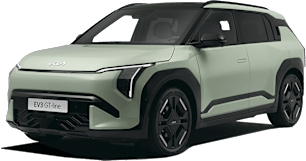In the Kia EV3 line-up, pricing ranges from $47,600 before on-road costs for the entry-level EV3 Air Standard Range, up to $63,950 for the GT-Line Long Range.
Impressively, Kia says the Air Standard Range is available for less than $50,000 drive-away, even in WA where it just sneaks in at $49,990. In other states and territories it comes with a $48,990 price.
There are three trim levels but four variants, with the Air Long Range, Earth Long Range and GT-Line Long Range all joining the Air Standard Range.
Stepping up to an Air Long Range is a $53,315 (before on-roads) ask, though both come with the same extensive list of features.
On the outside, 17-inch alloy wheels, dusk-sensing LED headlights, daytime running lights (DRLs) and partial LED tail-lights as well as roof rails and heated folding mirrors show the entry-level Air to be well equipped for a small SUV.
Inside, there’s a two-tone cloth interior with LED interior lighting, a two-spoke synthetic leather steering wheel and, of course, the large arrangement for a multimedia touchscreen and driver display. Dual-zone climate control is also standard, with automatic window defogging.
Those two screens are 12.3-inch units, while there’s also a central 5-inch touchscreen for climate controls between them. There’s has in-built navigation, wireless Apple CarPlay and Android Auto, voice recognition and a six-speaker sound system.
The base model also has a wireless phone charger and USB-C ports in both the front and rear rows, a 12-volt outlet in the front and a household-style power outlet in the second row for powering appliances or equipment. In addition, there’s also an external adapter with the same household-style plug that connects to the charging port as standard.
The mid-spec Earth goes for $58,600 before on-roads coming in Long Range only (as with the GT-Line).
On top of everything already included in the Air, the Earth gains a set of larger 19-inch alloy wheels, synthetic leather seats with heating and ventilation, the driver’s side being 10-way electrically adjustable, a heated steering wheel, an electro-chromatic (or glare-dimming) mirror, and a power tailgate.
As previously mentioned, the GT-Line costs $63,950 before on-roads, and adds a stack of features on top of the Earth, including a series of exterior design changes like 19-inch GT-Line alloys wheels, satin silver front and rear bumpers, body-coloured side garnishes, a sunroof and tinted rear glass.
The GT-Line’s LED headlights are also cubed projection headlights, and the tail-lights are fully LED.
Inside, there’s a three-spoke GT-Line steering wheel, alloy pedals, specific two-tone GT-line seats with the passenger side seat also becoming 10-way electrically adjustable, ambient LED mood lighting, a head-up display and the central upper storage compartment under the armrest becomes a slide-out tabletop.
As well as things like rear-view camera (a surround-view set-up is bizarrely unavailable range-wide) and front and rear parking sensors, the safety equipment across all three variants is the same, too, but we’ll get into more details later in the review.

